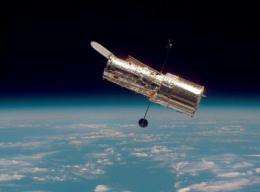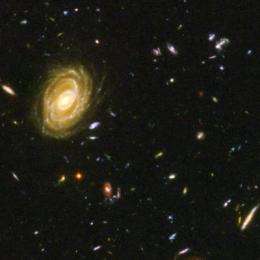Data mining deep space

Bahram Mobasher, a professor of physics and astronomy at the University of California, Riverside, has received a two-year $200,000 grant from NASA to compile into a data bank all the imaging observations of galaxy surveys that the Hubble Space Telescope has performed since 2002, when a powerful imaging instrument, the Advanced Camera for Surveys, was installed on the telescope.
Carried into orbit in 1990, the Hubble Space Telescope still remains in operation, and is one of the world's most famous, popular and productive scientific instruments. Because of its orbit outside the Earth's atmosphere, it is capable of taking extremely sharp images of galaxies in the most distant parts of the universe.
"This is a tremendously exciting data-mining project, a legacy program with a final product enormously useful for astronomers worldwide," Mobasher said.
The Hubble imaging data will be supplemented by observations for the same galaxies in different wavelengths, taken from other ground-based and space-borne observatories.

"Light at each wavelength reveals a different story about a galaxy," Mobasher explained. "By combining the multi-wavelength data, astronomers can measure the physical properties of galaxies and use them to study galaxy formation and evolution."
Given that the multi-waveband data are taken by different telescopes and instruments, astronomers will need to make the data consistent and on the same scale.
"This is a great challenge given the range of the telescopes used to acquire these data," said Peter Capak, a co-investigator on the project from the California Institute of Technology, Pasadena.
The multi-wavelength data bank will be used to measure physical parameters for individual galaxies, including their cosmological velocity, mass, type and the rate with which they form stars.
For use by the astronomical community, Mobasher and his team will provide, via an interface, comprehensive, multi-waveband catalogs and measured physical parameters for all the galaxies detected in the Hubble Space Telescope galaxy surveys.
"Such catalogs are essential for studying the formation and evolution of galaxies, their clustering and for searching for new generation of galaxies," Mobasher said. "The final products from this legacy study will wrap up all the imaging observations performed by the Hubble Space Telescope over the last ten years and provide an outstanding dataset for research for many years to come."
The proposal was selected for funding from a large pool of submitted proposals after a rigorous review by a team of prominent astronomers convened by NASA.
Mobasher, the principal investigator of the grant, will be joined in the research by his student Shoubaneh Hemmati at UC Riverside. Scientists at the Space Telescope Science Institute, Baltimore, Md., and the California Institute of Technology also will collaborate on the project.
Provided by University of California - Riverside



















